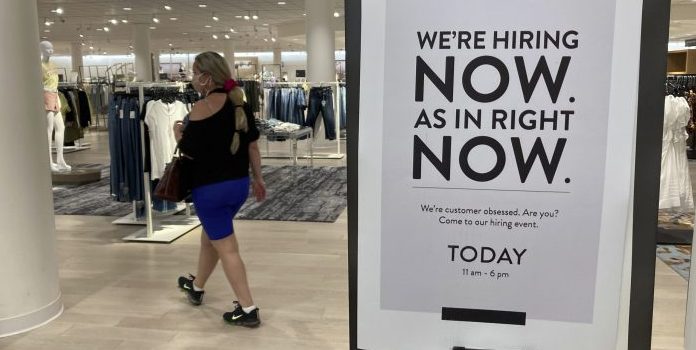(Headline USA) Americans increased their spending by 0.5% in April, a slowdown after a big gain in March that had been powered by the distribution of billions of dollars in individual stimulus checks.
Friday’s report also showed that inflation by a measure preferred by the Federal Reserve surged by a bigger-than-expected 3.6% for the 12 months that ended in April — an unsurprising development to those who understand the effects of massive money-printing. Even excluding the volatile food and energy categories, core inflation over that period was a still high 3.1%.
Both figures are far above the Fed’s 2% annual inflation target.
In its report Friday on consumer spending in April, the government said that goods purchases fell 0.6%. To some economists, this suggested that consumers have embarked on a long-anticipated shift away from the large goods purchases many of them had made while hunkered down at home to spending on services, from haircuts to airline tickets to restaurant meals.
“The great consumer spending rotation to services has begun,” said Gregory Daco, chief U.S. economist at Oxford Economics. “As health conditions continue to improve and the economy reopens, generous fiscal stimulus, rebounding employment and rising optimism will help unleash pent-up demand.”
Daco forecast that consumer spending, the main driver of the U.S. economy, could grow this year by around 9.5%.
Friday’s report from the Commerce Department also showed that personal incomes, which provide the fuel for spending, tumbled 13.1% in April.
But the drop in income was expected, having followed a record 20.9% income gain in March that reflected the billions in one-time checks to most adults.
The risk of a pickup in inflation continues to loom. Should inflation, which has been dormant for years, begin to accelerate on a sustained basis, it might compel the Fed to respond with interest rate hikes that could derail the recovery.
Gus Faucher, chief economist at PNC Financial, said that while the April inflation figures exceeded expectations, much of the increase related to supply-chain bottlenecks in such areas as computer chips and autos.
“We have some temporary inflation pressures,” Faucher said, “but those will fade, so there is nothing that the Federal Reserve is going to be concerned about.”
When asked about the rise in inflation, Chair Jerome Powell and other Fed officials have said repeatedly that they believe the inflation spikes that have surfaced with some goods will prove temporary as bottlenecked supply chains are unclogged.
On Thursday, Treasury Secretary Janet Yellen echoed this sentiment but also cautioned a House committee that the economy could endure a “bumpy” period with high inflation through year’s end.
The 3.6% increase in prices over the past 12 months was the largest year-over-year rise since September 2008. Excluding volatile food and energy costs, the 3.1% year-over-year rise in core inflation was the sharpest since 1992. And the one-month increase in core inflation in April, 0.7%, was the biggest since 1981.
In its report Friday on spending and income, the government also reported that the savings rate stood at a still high 14.9% in April, down from 27.7% in March. Many Americans built up saving over the past year, either from government stimulus checks or from hunkering down at home and avoiding much spending.
Adapted from reporting by Associated Press.

